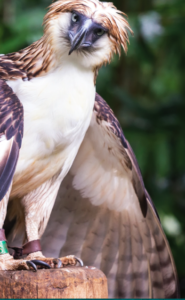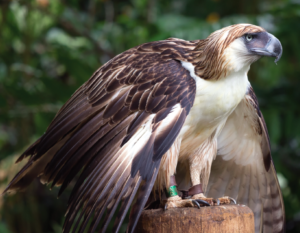For all our talk of Pinoy pride, our country’s standing as a megadiverse hotspot—and all the hard work our conversationists do to maintain this status—barely gets lip service.
Case in point: the Philippine Eagle (Pithecophaga jefferyi), one of the largest and rarest eagles in existence. Officially declared our country’s national bird by virtue of Presidential Proclamation No. 615, this avian predator is “a natural treasure found only in the Philippines and as such has become a source of national pride” and “whose uniqueness, strength, power, and love for freedom, exemplifies the Filipino people.”
And yet, except in instances of violence—the most recent of which took place in August 2015 in which Pamana, recently released to the wild, was murdered—the Philippine Eagle flies under the radar of the mainstream public. Here’s a brief primer on why we should take pride in the Philippine Eagle and why we should take the necessary steps to ensure that future generations
get to bask in its befeathered glory.

1) It is endemic to the Philippines
The Philippine Eagle can only be found in four of the country’s 7,107 islands: Luzon, Samar, Leyte, and Mindanao. The Philippine Eagle made its first appearance in recorded scientific history on June 15, 1896, when the English naturalist John Whitehead first sighted it in Paranas, Samar. Whitehead would go on to document his findings on Philippine birds in a series of co-authored articles with the Scottish ornithologist William Robert Ogilvie-Grant for The Ibis, the peer reviewed journal of the British Ornithologists’ Union.
2) Its size and wingspan stand on par with those of the world’s largest raptors
A typical Philippine Eagle stands at 3 feet (3’1” for males and up to 3’5” for females); its wingspan more than double the length at 7 feet, making it the broadest on record among extant eagle species. Other distinct features include its massive arched beak, heavy yellow legs, and long crown feathers (its brown, shaggy feathers form a lion-esque mane atop its brown-and-white colored body). It is also the world’s only blue-eyed bird of prey, with vision eight times more powerful than the human eye.

3) “Haring Ibon” rules the forest
As top predator of the Philippines’ rainforests, the Philippine Eagle plays a key role in maintaining the delicate balance of its ecosystem. Previously known as the monkey-eating eagle—based on the misconception that it fed solely on primates—the Philippine Eagle has since been observed to feast on other small animals, such as flying lemurs, squirrels, civets, snakes, hornbills, and bats. The Philippine Eagle nests on large dipterocarp trees in lowland tropical rainforests; the Dipterocarpae family consists of 17 genera and approximately 500 species of trees. It is fiercely territorial and requires large swaths of forest for hunting and breeding; as such, deforestation is one of two major causes of species loss.
4) Philippine Eagles believe in #mayforever
Solitary creatures they may be, but once a Philippine Eagle finds its mate, they are partners for life. Breeding season takes place from July to February, but it takes 5 to 7 years for eagles to sexually mature. (Hence the other primary cause of species loss: the high mortality rate of juveniles and subadults, often at the hands of humans). Human couples can also learn a thing or two about family planning and co-parenting from our eagle counterparts. Mated pairs only lay a single egg once every two years, the approximate time it takes for an eaglet to survive on its own. Male and female parents alternate incubating duties during the 60-day gestation period, and revert to more “traditional” roles in the first 40 days of an eaglet’s life: the male parent takes charge of hunting, while the female takes care of child rearing.

5) It is the only extant eagle of its kind
The Philippine Eagle Foundation notes that: “[Pithecophaga jefferyi] represents a rare product of evolutionary creation. Based on recent genetic studies, it has no close relatives left among the living species of eagles in the world. Losing them would mean an irreversible loss of a unique species.” The Foundation estimates that there is a maximum of 400 pairs remaining in the wild, mostly in Mindanao. As of 2003, six pairs have been sighted in Samar, two in Leyte, and a few in Luzon.
6) It is on the top spots of important endangered species watchlists
The Philippine Eagle has been classified as “Critically Endangered” by the International Union for the Conservation of Nature (IUCN) Red List since 1994. The IUCN cites its extremely small population size, and “extremely rapid declines in the past three generations” as its justification for the eagle’s Red List status. The EDGE of Existence program, a research and conservation initiative on Evolutionarily Distinct and Globally Endangered (EDGE) species, ranks the Philippine Eagle eighth on its list of Top 100 most endangered birds in the world—the first of five eagles on the list. (The list also includes another endemic Philippine bird, the Cebu Flowerpecker).
7) Conservation efforts have achieved modest success
While the declining population remains a major cause of concern, credit must be given where it is due: both government and conservation NGOs have ramped up their initiatives since the 1970s. Legislative measures have been enacted to prohibit acts of violence and trade, and funds have been earmarked for the protection of wildlife resources. The Philippine Eagle Foundation has been actively pursuing wildlife surveys and research, public awareness and fundraising, captive breeding, and reintroduction to its native habitat. Indeed, existing specimens have shown that the Philippine Eagle can live over four decades in captivity—the task is to ensure that it thrives just as long in the wild.
This appeared in Animal Scene’s November 2015 issue.






